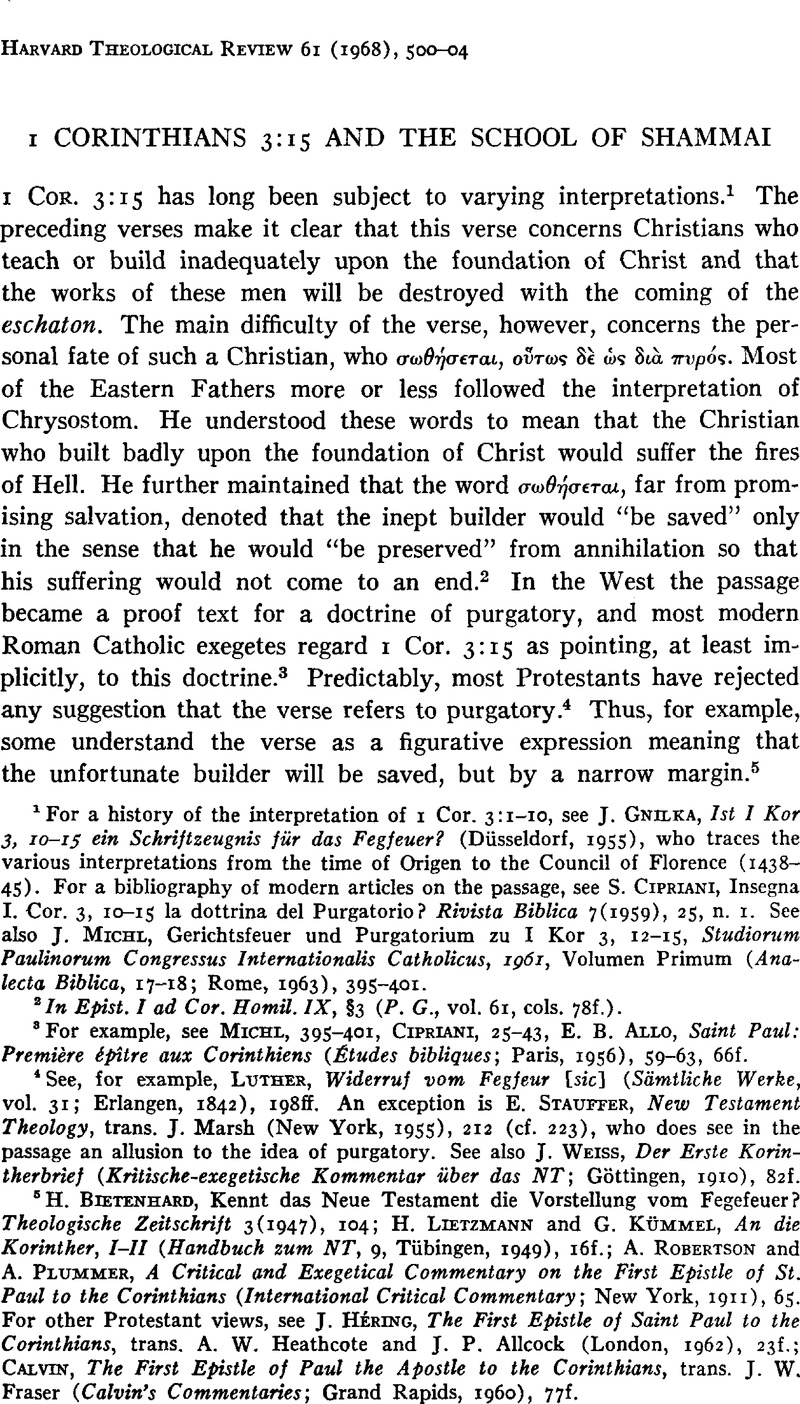Published online by Cambridge University Press: 10 June 2011

1 For a history of the interpretation of 1 Cor. 3:1–10, see Gnilka, J., Ist I Kor 3, 10–15 ein Schriftzeugnis für das Fegfeuer? (Düsseldorf, 1955)Google Scholar, who traces the various interpretations from the time of Origen to the Council of Florence (1438–45). For a bibliography of modern articles on the passage, see Cipriani, S., Insegna I. Cor. 3, 10–15 la dottrina del Purgatorio? Rivista Biblica 7(1959), 25Google Scholar, n. 1. See also J. Michl, Gerichtsfeuer und Purgatorium zu I Kor 3, 12–15, Studiorum Paulinorum Congressus Internationalis Catholicus, 1961, Primum, Volumen (Analecta Biblica, 17–18; Rome, 1963), 395–401Google Scholar.
2 In Epist. I ad Cor. Homil. IX, §3 (P. G., vol. 61, cols. 78f.).
3 For example, see Michl, 395–401, Cipriani, 25–43, Allo, E. B., Saint Paul: Première épître aux Corinthiens (Études bibliques; Paris, 1956), 59–63, 66f.Google Scholar
4 See, for example, Luther, Widerruf vom Fegfeur [sic] (Sämtliche Werke, vol. 31; Erlangen, 1842), 198ff. An exception is E. Stauffer, New Testament Theology, trans. J. Marsh (New York, 1955), 212 (cf. 223), who does see in the passage an allusion to the idea of purgatory. See also J. Weiss, Der Erste Korintherbrief (Kritische-exegetische Kommentar über das NT; Göttingen, 1910), 82f.
5 Bietenhard, H., Kennt das Neue Testament die Vorstellung vom Fegefeuer? Theologische Zeitschrift 3(1947), 104Google Scholar; Lietzmann, H. and Kümmel, G., An die Korinther, I–II (Handbuch zum NT, 9, Tübingen, 1949), 16f.Google Scholar; Robertson, A. and Plummer, A., A Critical and Exegetical Commentary on the First Epistle of St. Paul to the Corinthians (International Critical Commentary; New York, 1911), 65Google Scholar. For other Protestant views, see Héring, J., The First Epistle of Saint Paul to the Corinthians, trans. Heathcote, A. W. and Allcock, J. P. (London, 1962), 23f.Google Scholar; Calvin, , The First Epistle of Paul the Apostle to the Corinthians, trans. Fraser, J. W. (Calvin's Commentaries; Grand Rapids, 1960), 77f.Google Scholar
6 However, most of the parallels cited to support the view that Paul is merely using a proverbial expression are not overly convincing, e.g., Livy XXII, 35, 3: “Prope ambustus evaserat.” See Lietzmann-Kümmel, 17. Cf. also Weiss, 83, n. 1, who cites several parallels, although he believes that the Apostle's words here are more than proverbial.
7 The baraita is understood thus in Strack, H. L. and Billerbeck, P., Kommentar zum Neuen Testament aus Talmud und Midrasch (Munich, 1954–56), vol. 4, 1032f.Google Scholar Although Strack-Billerbeck cite both the baraita in Rosh ha-Shanah 16a–17b (p. 1033; cf. pp. 1044, 1050) and its parallel in TSanhedrin 13:3 (p. 1178; cf. p. 1044), this work never indicates that the passages are in any way related to 1 Cor. 3:10–15. Similarly Bietenhard knows of this Shammaitic teaching (p. 115) but does not use it in his discussion of the Corinthian passage (p. 104).
8 Even apart from the Apostle's claims, his use of Rabbinic teachings has often been demonstrated. See, for example, Davies, W. D., Paul and Rabbinic Judaism (London, 1935)Google Scholar.
9 For example, in The Pharisees (Morris Loeb Series, No. 2, The Jewish Publication Society; Philadelphia, 1962)Google Scholar.
10 The improbable claim in Acts 22:3 that Paul was a pupil of Gamaliel, even if true, would not necessarily prove that the Apostle was a Hillelite like the noted teacher. Students do not always follow the leanings of their masters. In fact, there is reason to believe that Gamaliel's own son was a Shammaite. See Finkelstein, , Akiba (Meridian Books, JP25; Cleveland, 1962), 46ff.Google Scholar
11 So, for example, Doeve, J. W., Jewish Hermeneutics in the Synoptic Gospels and Acts (Assen, 1954), 72f.Google Scholar
12 So Rabinowitz, J. J., The Sermon on the Mount and the School of Shammai, Harvard Theological Review 49 (1956), 79.CrossRefGoogle Scholar
13 See Moore, G. F., Judaism (Cambridge, Mass., 1954), II, 189.Google Scholar
14 See Finkelstein, Pharisees, 181–85.
15 See Kerithoth 1:7; Finkelstein, Akiba, 50f.
16 So Bietenhard, 103f. Cf. Acts 5:1–11.
17 See, for example, Bietenhard, 104f.